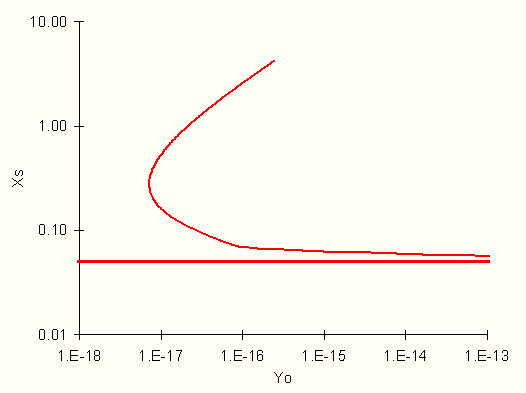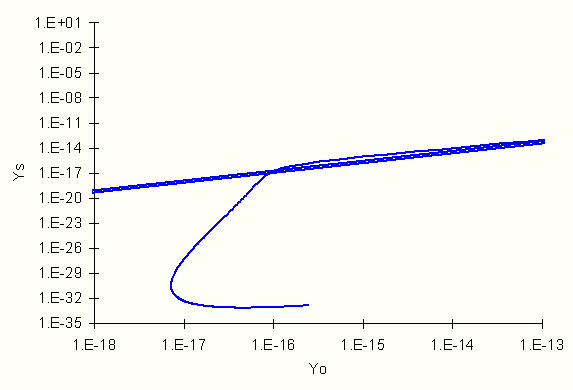CHEM E 475
Homework Sheet No. 6
November 20, 1996
These questions pertain to the polymerization reactor as described by Hoftyzer and Zwietering, Chem. Eng. Sci., vol. 14, 241 (1961).
The non-dimensional equations describing the relationship between x and y are:
 |
(1) |
 |
(2) |
The following parameters apply:
u = 1.68
v = 3 x 10-18
19. Prepare a graph of xs versus y0 for x0 = 0.05 following the figure from Hoftyzer and Zwietering. Also prepare a graph of ys versus y0 for x0 = 0.05. (Adiabatic Case)
For the steady state, adiabatic case equations (1) and (2) become:
 |
(3) |
 |
(4) |
Now, solving (3) for y0 and (4) for ys yields:
 |
(5) |
 |
(6) |
From these equations, the following graphs can be charted.
For xs as a function of y0 for x0 = 0.05:

For ys as a function of y0 for x0 = 0.05:

20. Solve for the steady state [non-dimensional] concentration and [non-dimensional] temperature when y0 = 10-16 and xo = 0.05.
From the graphs in problem 19, it is evident there are 4 solutions to this problem: However, due to the huge gradient very close to xs=0.05, the solutions in that area could not be calculated. The values where xs > 0.06 are as follows:
xs |
ys |
6.9060E-02 |
2.5804E+00 |
2.5804E+00 |
8.4758E-34 |
(Using tolerances of 1 x 10-8 to 1 x 10-9 showed agreement to 6 significant figures)
21. Consider the reactor when the heat removal term just balances the heat generation term so that the temperature is constant. Prepare a graph of ys versus y0 for xo = 0.05 under these conditions.
If dx/dz is zero, then xs = x0 for all z. Therefore equation (3) becomes:
 |
(7) |
When solved for ys, equation (7) yields:
 |
(8) |
Which is a linear relationship with y0. The following graph illustrates this:

Appendix, Calculations
The following Matlab functions were created for accomplishing this homework:
To solve Equation (5):
function
yo=yo19(xs)
%
% Constants
%
u = 1.68 ;
v = 3.0e-18 ;
%
% Calculate yo
%
ys = ys19( xs ) ;
yo = ys * ( 1 + 1 / v * exp( - ( 1 + u ) / xs ) ) ;
end
To solve Equation (6)
function
ys=ys19(xs)
%
% Constants
%
u = 1.68 ;
v = 3.0e-18 ;
xo = 0.05 ;
%
% Calculate ys
%
ys = ( 2 * v * ( xs - xo ) / exp( - u / xs ) ) ^ 2 ;
end
To help solve equation (5) for a given y0 value.
function
yo_diff = search20(xs)
yo_diff = 1 - yo19(xs)/(1e-16) ;
end
To solve equation (8):
function
ys=ys21(yo)
%
% Constants
%
u = 1.68 ;
v = 3.0e-18 ;
xo = 0.05 ;
%
% Calculate ys
%
ys = v * yo / ( exp( - ( 1 + u ) / xo ) + v ) ;
end
Checking yo19 and ys19 by hand:

![]()
From the Matlab command line:
EDUŠ ys19( 0.06 )
ans =
7.529974185646778e-015
EDUŠ yo19( 0.06 )
ans =
7.630247500989692e-015
Which appear to agree.
Check search20 by hand:
![]()
From the Matlab command line:
EDUŠ search20( 0.06 )
ans =
-7.530247500989694e+001
Which appears to agree as well.
Finally checking ys21:

(Which loses significant figures on my calculator, the exponential value is of the order of 1.1 x 10-24 which is lost in the 3 x 10-18 term-)
From the Matlab command line:
EDUŠ ys21( 1e-13 )
ans =
9.999982433155688e-014
Which has more precision than my hand calculator.
The numbers for problem 19 were generated with the following script:
for i = 1:200 %also (1:400) xs( i ) = ( i + 2 ) / 1000 ; %also (i+20)/100 ys( i ) = ys19( xs( i ) ) ; yo( i ) = yo19( xs( i ) ) ; end xs = xs' ys = ys' yo = yo' plot(yo,xs)
and then copied into Excel for graphing. The numbers for Problem 20 were obtained by the following:
EDUŠ xs = fzero( 'search20', 0.048, 1e-8 ) xs = 6.905973044876815e-002 EDUŠ xs = fzero( 'search20', 0.048, 1e-9 ) xs = 6.905973044877588e-002 EDUŠ xs = fzero( 'search20', 2.0, 1e-8 ) xs = 2.580376338595115e+000 EDUŠ xs = fzero( 'search20', 2.0, 1e-9 ) xs = 2.580376338595115e+000 EDUŠ ys19( xs ) ans = 8.475846061828390e-034
The following script was used to generate the data for problem 21.
for i = 1:180 yo( i ) = 10 ^ ( - i /10 ) ; ys( i ) = ys21( yo( i ) ) ; end yo = yo' ys = ys'
Return to Polymerization Page